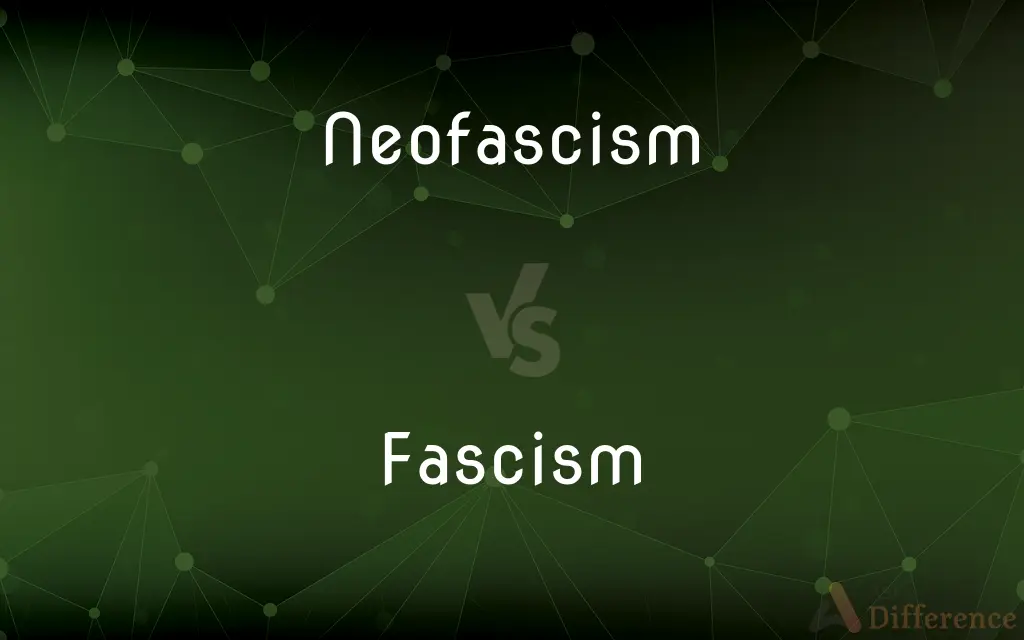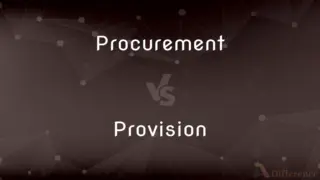Neofascism vs. Fascism — What's the Difference?
By Tayyaba Rehman & Maham Liaqat — Updated on April 8, 2024
Neofascism is post-World War II ideology that includes ultra-nationalistic and authoritarian elements, mirroring traditional fascism. Fascism is characterized by dictatorial power, forcible suppression of opposition, and strong regimentation of society.

Difference Between Neofascism and Fascism
Table of Contents
ADVERTISEMENT
Key Differences
Neofascism arises as a modern adaptation of fascism, reflecting changes in political, social, and technological landscapes. It often incorporates contemporary issues and rhetoric, including anti-globalization, nationalism, and xenophobia, while leveraging modern technology for propaganda and organization. Fascism, on the other hand, originated in the early 20th century, notably with Mussolini's Italy and Hitler's Germany, emphasizing the totalitarian control of a state by a dictator, aggressive nationalism, and the suppression of political opposition through violence and censorship.
While both ideologies share core elements such as authoritarianism, nationalism, and the desire for a unified national community, neofascism differs in its context and methods of propagation. Neofascists might not explicitly align with historical fascist regimes or symbols but instead focus on contemporary issues and use modern communication methods to spread their message. Fascism, historically, was more directly involved with the state's overt control and expansion through military conquest and the creation of a centralized, authoritarian government.
Neofascism tends to emerge in democratic societies, often working within the political system to gain power, and might not always seek to establish a totalitarian government. It often exploits economic insecurities, cultural fears, and the perceived threats of immigration and globalization. Traditional fascism, in contrast, arose in the aftermath of World War I, exploiting the chaos, economic instability, and the fear of communism to establish dictatorial regimes.
The approach to economic policies also differs. Neofascist movements may not pursue the extensive state control over the economy characteristic of historical fascism but may support a mixed economy with nationalist priorities. Fascism historically advocated for a corporatist economy where industry and government collaborated to control the economy, aiming to create a harmonious national unity and eliminate class conflict.
Despite these differences, both neofascism and fascism fundamentally seek to unite their respective populations against perceived internal and external enemies, using a combination of glorified nationalism, fear-mongering, and the promise of returning to a greater, more powerful state. However, neofascism's adaptation to the modern world means it faces different challenges and opportunities than its predecessor, particularly in how it engages with global issues and technology.
ADVERTISEMENT
Comparison Chart
Origin
Post-World War II
Early 20th Century, notably in Italy and Germany
Key Features
Ultra-nationalism, authoritarianism, contemporary issues
Dictatorial power, aggressive nationalism, state control
Methods of Propagation
Modern technology, social media
State-controlled media, public rallies
Political Context
Often arises within democratic societies
Emerged in post-WWI chaotic environments
Economic Policies
Mixed, with nationalist priorities
Corporatist, state control over economy
Approach to Opposition
Uses legal systems, misinformation
Forcible suppression, violence
Focus
Contemporary issues, anti-globalization
National unity, expansion, class collaboration
Compare with Definitions
Neofascism
A modern movement using social media for nationalist propaganda.
Neofascist groups often spread their ideology through online platforms.
Fascism
Originated with Mussolini's Italy, emphasizing totalitarian control.
Fascism in Italy established a one-party dictatorship.
Neofascism
Emphasizes anti-immigration and anti-globalization sentiments.
Neofascist rhetoric frequently targets global institutions and foreign migrants.
Fascism
Relied on public rallies and state media for propaganda.
Large, choreographed rallies were a hallmark of fascist regimes to show support.
Neofascism
Seeks power within existing political systems.
Neofascist parties might participate in elections to gain legislative influence.
Fascism
Promoted aggressive nationalism and expansionism.
Nazi Germany, under fascist ideology, pursued territorial expansion in Europe.
Neofascism
Utilizes modern technology for organization and propaganda.
The use of internet forums and encrypted messaging apps to coordinate activities.
Fascism
Suppressed opposition through violence and censorship.
Fascist regimes used secret police and state-controlled media to eliminate dissent.
Neofascism
Adapts traditional fascist ideals to contemporary contexts.
Neofascists may focus on current socio-economic issues while promoting authoritarianism.
Fascism
Implemented a corporatist economy.
Fascist Italy sought to harmonize the interests of workers, businesses, and the state.
Neofascism
A movement inspired by the tenets and methods of fascism or Nazism.
Fascism
Fascism () is a form of far-right, authoritarian ultranationalism characterized by dictatorial power, forcible suppression of opposition, and strong regimentation of society and of the economy, which came to prominence in early 20th-century Europe. The first fascist movements emerged in Italy during World War I, before spreading to other European countries.
Neofascism
A right-wing political movement inspired by fascism, especially by that of fascist Italy.
Fascism
An authoritarian and nationalistic right-wing system of government and social organization.
Fascism
A system of government marked by centralization of authority under a dictator, a capitalist economy subject to stringent governmental controls, violent suppression of the opposition, and typically a policy of belligerent nationalism and racism.
Fascism
A political philosophy or movement based on or advocating such a system of government.
Fascism
Oppressive, dictatorial control.
Fascism
Any right-wing, authoritarian, nationalist ideology characterized by centralized, totalitarian governance, strong regimentation of the economy and society, and repression of criticism or opposition.
Fascism
Any system of strong autocracy or oligarchy usually to the extent of bending and breaking the law, race-baiting, and/or violence against largely unarmed populations.
Fascism
Any extreme reliance on or enforcement of rules and regulations.
Fascism
A political theory advocating an authoritarian hierarchical government; - opposed to democracy and liberalism.
Fascism
An authoritarian system of government under absolute control of a single dictator, allowing no political opposition, forcibly suppressing dissent, and rigidly controlling most industrial and economic activities. Such regimes usually try to achieve popularity by a strongly nationalistic appeal, often mixed with racism.
Fascism
Specifically, the Fascist movement led by Benito Mussolini in Italy from 1922 to 1943.
Fascism
Broadly, a tendency toward or support of a strongly authoritarian or dictatorial control of government or other organizations; - often used pejoratively in this sense.
Fascism
A political theory advocating an authoritarian hierarchical government (as opposed to democracy or liberalism)
Common Curiosities
What is neofascism?
Neofascism is a post-World War II ideology incorporating ultra-nationalism and authoritarianism, adapted to modern contexts.
How does neofascism differ from traditional fascism?
Neofascism adapts fascist principles to contemporary issues and utilizes modern technology for propaganda, often operating within democratic systems.
What led to the rise of fascism in the 20th century?
Fascism rose from post-WWI chaos, economic instability, and fears of communism, offering a unified nationalistic and authoritarian alternative.
Are neofascism and fascism considered the same?
While sharing core elements like nationalism and authoritarianism, neofascism and fascism differ in context, methods, and sometimes economic policies.
How did fascists use propaganda?
Fascists used state-controlled media, public rallies, and visual symbols to spread their ideology and suppress opposition.
How do fascists view the economy?
Historically, fascists supported a corporatist economy with significant state intervention to control and direct economic activity for national unity.
Can neofascist movements be found in democracies?
Yes, neofascist movements often emerge and operate within democratic societies, seeking power through political systems.
How did fascism aim to eliminate class conflict?
Fascism aimed to eliminate class conflict through a corporatist economy that emphasized collaboration between employers and employees under state oversight.
What is a key feature of neofascist movements?
A key feature is their emphasis on contemporary issues, such as anti-globalization, using modern communication methods.
Did fascists pursue territorial expansion?
Yes, territorial expansion was a key aspect of fascist ideology, notably in Nazi Germany's pursuit of Lebensraum ("living space").
What role does technology play in neofascism?
Technology plays a significant role in spreading neofascist ideas, organizing activities, and creating online communities.
How do neofascists view globalization?
Neofascists often oppose globalization, seeing it as a threat to national identity and sovereignty, and advocate for nationalist policies.
Can neofascism be legally recognized and opposed?
Yes, many democracies have laws to recognize and oppose neofascist activities, including hate speech and discrimination legislation.
Share Your Discovery

Previous Comparison
Procurement vs. Provision
Next Comparison
Peg vs. PinAuthor Spotlight
Written by
Tayyaba RehmanTayyaba Rehman is a distinguished writer, currently serving as a primary contributor to askdifference.com. As a researcher in semantics and etymology, Tayyaba's passion for the complexity of languages and their distinctions has found a perfect home on the platform. Tayyaba delves into the intricacies of language, distinguishing between commonly confused words and phrases, thereby providing clarity for readers worldwide.
Co-written by
Maham Liaqat













































